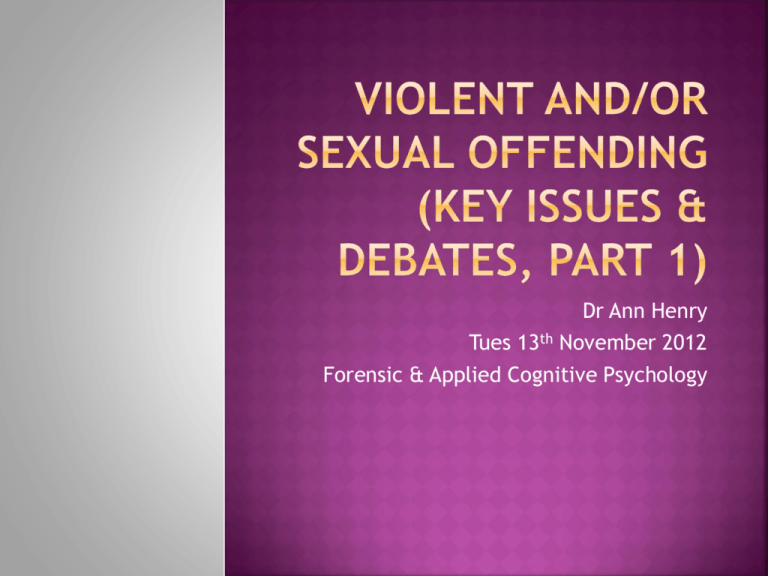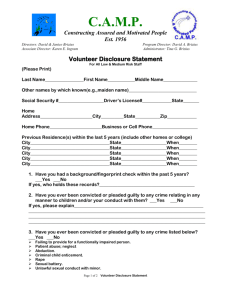
Dr Ann Henry
Tues 13th November 2012
Forensic & Applied Cognitive Psychology
Different
Criminal
types of mental illness/ disorder
Justice System
Treatments
in mental health settings
Risk
Assessment (brief overview)
Theories
Sexual
of crime
Offending – paedophiles & child
molestation
Recidivism – relapse into crime
Risk & dangerousness
Various statistical measures: PCL-R, HCR-20
(Historical, Clinical, Risk), SVR-20 (Sexual
Violence Risk) etc.
Risk factors: Static & Dynamic
Static factors (e.g. age, gender, history of
violence, personality disorder, major mental
illness etc.)
Dynamic factors (e.g. emotional & cognitive
disposition, impulsivity, active symptoms of
major mental illness, location, associates, lack
of support)
Howitt
(2006) outlines a broad range of
theories.
Macro-level
or Societal
Community or locality
Group & socialisation influence
Individual/ Psychological
Marxist
Conflict theory
Merton’s
Strain Theory
Feminist
Theory
Marxist
Society
conflict theory
has evolved in a state of conflict
between competing groups in society over
material resources & institutionalised power.
Dominant class uses laws to control other
groups & maintain its command or hegemony
(political leadership)
Merton’s
Strain Theory
Recognises
that society’s goals (prosperity,
achievement etc.) are only available to a
limited few. The rest can only achieve goals
through deviant means.
Others adapt to the strain by retreating into
alcoholism, drug addiction, suicide,
vagrancy.
Feminist
Holds
Theory
that criminality is associated with
males. Males seek to maintain power in the
gendered social system through the
deployment of violence against women &
children.
Male control is through their access to power
over social institutions such as the law.
Powerless men are inclined to the cruder
expressions of power which lead to their
imprisonment.
Differential
Opportunity theory
Explains
the patterns of crime likely to be exhibited
by individuals in terms of the range of crime
opportunities close to home.
Different
individuals display different modes of
adjustment or adaptation to their particular social
strains.
Subcultural
Delinquency Theories
Differential Association Theory
Lifestyle & Routine Activities Theory
Social Learning Theory
Criminogenic factors in childhood
Subcultural
Delinquency Theories
Youngsters
with problems especially to do
with the home & school tend to associate
with gangs & other groupings in which they
can achieve some status.
Through
criminal activity, delinquent groups
may provide an opportunity to achieve a
sense of self-esteem.
Differential
Association Theory
Circumstances
of upbringing determines their
exposure to crime & pressure to commit
crime.
Hence, learning to be a criminal applies to
different strata of society e.g. middle class
might be exposed to fraud, tax evasion etc.
Lifestyle
Argues
& Routine Activities Theory
that most crime is trivial & impulsive
– thus elements of opportunism (Cohen &
Felson, 1979)
Social
Learning Theory
Bandura
(1973, 1983) Vicarious learning
through observing other people.
However,
doesn’t explain under what
circumstances criminal behaviour will or will
not be learnt, so has limited explanatory
power.
Criminogenic
factors in childhood
Glueck & Glueck, 1962, 1968) claim that the following are
antecedents of antisocial & criminal behaviour:
Punitive child-rearing practices & attitudes (strict
discipline, corporal punishment, authoritarian attitudes)
Lack of love or rejection
Laxness (poor monitoring, lack of supervision)
Family disruption (separation, divorce, instability, marital
conflict)
Deviant parental characteristics (criminality, mental health
problems, substance abuse)
Criminogenic
factors in childhood (cont)
Yoshikawa (1995) argued that delinquency is
product of interaction of multiplicity of factors:
Neurological & biological factors
Low cognitive ability
Childhood history of antisocial behaviour
Parental substance abuse
Violent or socially disorganised neighbourhoods
Media violence
Criminogenic factors in childhood (cont)
Farrington (1996) claims that childhood conduct
disorder and adult Antisocial Personality Disorder
have the same aetiological precursors:
Low family income
Poor housing
Large family size
Convicted parents
Harsh or erratic parental discipline
Low intelligence
Early school leaving
Protective
factors from delinquency
Farrington (1998)
Personal Resources – resilient youngsters had
better technical/spatial intelligence, flexible
temperaments, approach-orientated, more
positive self-esteem & active coping styles
Social Resources – resilient youngsters were
more satisfied with social support &
experienced openness, autonomy & low
conflict in their residential institution.
Personality
Theories
Biological Theories
Attachment Theory
Isomorphism hypothesis
Personality
Eysenck’s
Theories
biosocial theory emphasises link
between biological factors, personality &
crime.
High extraversion, high psychoticism & high
neuroticism
Biological
Theories
Genetics
e.g. genetic make-up, brain
activity, hormonal imbalances
Evolutionary theory – inherited genes
Body shape type: mesomorph, endomorph &
ectomorph
Evidence
is contradictory and controversial
Attachment
theory
Based on John Bowlby’s work in 1950s
Bonding & attachment in infancy & early
childhood
Internal Working Model
Different types of attachment: Secure and
Insecure
Ainsworth (1970s)- classified insecure into
Anxious-Avoidant, Anxious-Ambivalent &
Disorganised
Isomorphism hypothesis
Close relationship between the characteristics of abuse
and its effect on the victim.
Widom (1989) explored links between childhood abuse and
adult criminality.
Victims of physical abuse have highest rates of violent
offences (16% of sample)
Victims of neglect had similar levels of violence (13%)
Controls (not abused as children) had 7% risk of violent
offending in adulthood
Hence, evidence is inconclusive & other factors need to be
taken into consideration (see previous list re criminogenic
factors)
Howitt
(2006) summarises that there is little
reliable evidence of the link between
intelligence level and crime.
Controversial
topic as also linked to the
debate about race and intelligence.
Constructions
Social
Cultural
Historical
of crime
Media
coverage – recent Jimmy Saville case
& other cases of paedophilia/ child sexual
abuse/ abusers
Extreme hostility & negative stigma towards
paedophiles
Recidivism comparatively low
Megan’s law (USA) Megan abducted &
murdered in 1994
Controversial & inconclusive research on role
of pornography & sexual offending
Internet paedophiles
paedophiles
Rapists
& child molesters
(cover in lecture 4 on Tues 20th Nov)
Classifications
of child molesters (Groth &
Birnbaum, 1978)
Fixated
Offenders
Developmentally
fixated on a permanent or
temporary basis. Sexual interest in children
rather than adults.
Regressed
Men
Offenders
matured in their sexuality but return to
an earlier level of psychosexual
development.
Psychosexual history shows primary interest
in peer aged or adult individuals, rather than
younger ones
How
common is paedophilia?
Unclear as depends on definition of sexual
abuse used e.g. indecent assault, gross
indecency, buggery, intercourse, rape.
Non-paedophile sexual arousal – conflicting
findings (Hall et al, 1995)
Youthful
offenders
Graves et al (1996) in USA found that up to
half of child sexual abuse carried out by
persons under age of 21
Theories
of Paedophilia
Preconditions
model
Psychotherapeutic/ cognitive model
Sexualisation model
Pathways model
Preconditions model of child molestation
Araji & Finkelhor (1985)
1) Emotional congruence with children (lack selfesteem, psychosocially immature, may have need to
dominate)
2) Social arousal by children (child pornography,
hormonal abnormalities/ imbalances)
3) Blockages preventing adult contact (lack effective
social skills, problems relating to adult females,
repressive sexual socialisation in childhood)
4) Disinhibition of norms against adult/child sex
(offenders may be senile, alcohol may decrease
inhibitions, incest-tolerant subculture)
Psychotherapeutic/
Suggests
cognitive model
4 steps
1) Cognitive distortions/ distorted thinking
e.g. having sex with a child is a good way of
an adult teaching a child about sex. Beliefs
about sexual nature of children.
2) Grooming (bribes of sweets, other treats,
trips out, threats of violence)
3) Planning through fantasy
4) Denial – denying the consequences of their
actions
Sexualisation
model
Howitt (1995) Experience of sexual abuse in
childhood is a developmental process which
can lead to paedophilia.
Early
sexual abuse – especially if extreme or
repeated - possible sexual experience with
peers- adolescent paedophile career –
paedophile adult
Controversial theory as women are more
likely to be victims of childhood sexual, but
less likely to be sexual offenders
Pathways
model (Ward & Siegert, 2002)
Multi-factorial model – combining elements
of previous models/ theories
Distal & Proximal factors
Distal factors (predispositions e.g. genetic/
childhood development)
Proximal factors (that might trigger
predispositions e.g. environment, negative
mood state)
4
psychological mechanisms
1)
Intimacy & social skills deficits
2) Deviant sexual scripts
3) Emotional dysregulation
4) Cognitive distortions
Children
as sexual objects
Entitlement- to have their sexual needs met
Dangerous world – children seen as reliable &
trusting & gives offender comfort against
danger
Uncontrollable – claims not to be on control
of own actions & blames outside factors e.g.
drugs/ alcohol
Nature of Harm – believes not all sexual
activity is harmful & children can benefit
from sexual activity with adults
Internet
Paedophile offending
Controversial topic – whether linked to
contact paedophilia or not
Robbins
& Darlington (2003) 27,000 people in
the world go onto child pornography sites
every day. I million images of child sexual
abuse in circulation.
Internet chat rooms
Sexual fantasy vs contact sexual acts with
children
Risk
Assessment
Theories
Sexual
of crime
Offending – paedophiles & child
molestation
Murphy, W.D. & McGrath, R. (2008).
Best Practices in Sex Offender Treatment, Prison
Service Journal, issue 178, pgs 3-9.
Strickland, S.M (2008). Female Sex Offenders:
Exploring Issues of Personality, Trauma and
Cognitive Distortions, J Interpers Violence 2008;
23; p. 474-489.
Towl, G.J., Farrington., D.P., Crighton, D.A. &
Hughes, G. (2008). Dictionary of Forensic
Psychology, Devon, Willan Publishing.
Ward. T. & Stewart, C. (2003). The relationship
between human needs and criminogenic needs,
Psychology, Crime & Law, September 2003, Vol.
9(3), pp. 219 /224
No
Lecture on Mon 19th Nov
Rapists
Treatment
of Sexual offenders
Violent Offending





